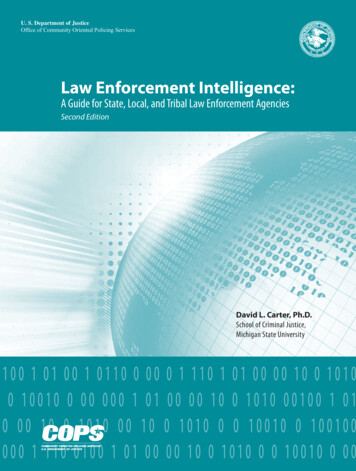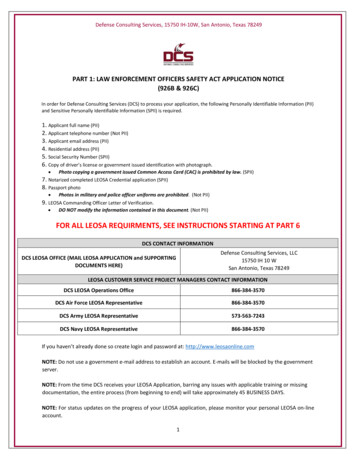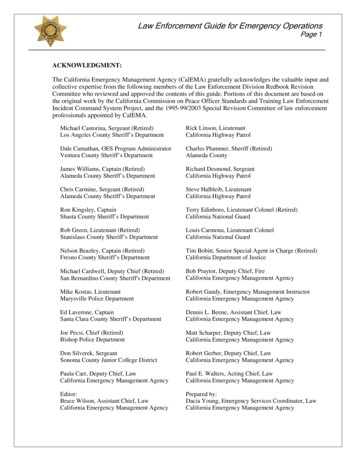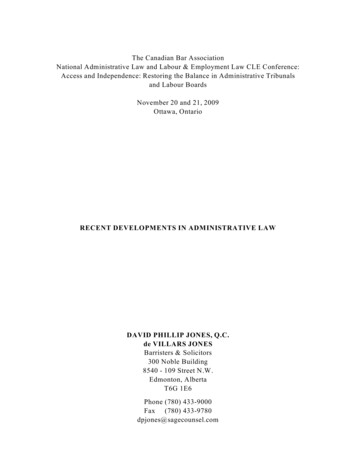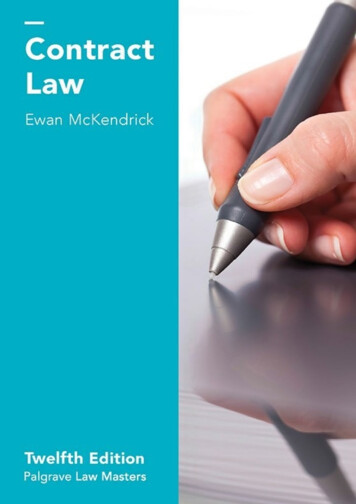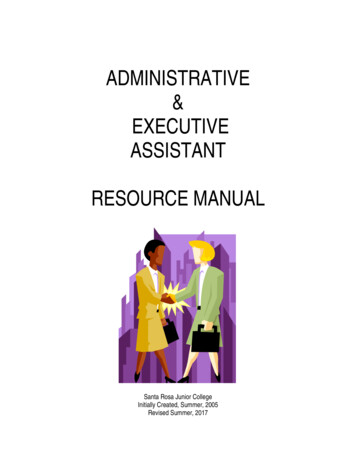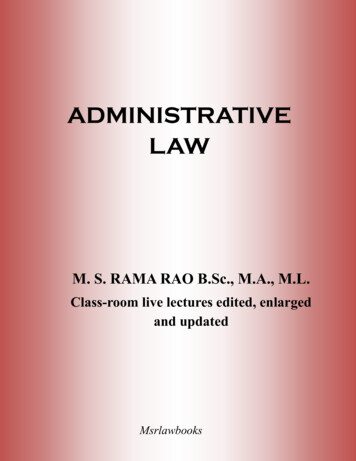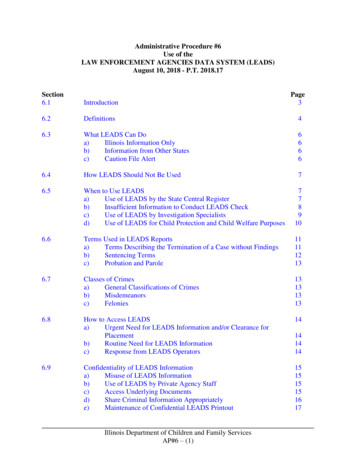
Transcription
Administrative Procedure #6Use of theLAW ENFORCEMENT AGENCIES DATA SYSTEM (LEADS)August 10, 2018 - P.T. .3What LEADS Can Doa)Illinois Information Onlyb)Information from Other Statesc)Caution File Alert66666.4How LEADS Should Not Be Used76.5When to Use LEADSa)Use of LEADS by the State Central Registerb)Insufficient Information to Conduct LEADS Checkc)Use of LEADS by Investigation Specialistsd)Use of LEADS for Child Protection and Child Welfare Purposes7789106.6Terms Used in LEADS Reportsa)Terms Describing the Termination of a Case without Findingsb)Sentencing Termsc)Probation and Parole111112136.7Classes of Crimesa)General Classifications of Crimesb)Misdemeanorsc)Felonies131313136.8How to Access LEADSa)Urgent Need for LEADS Information and/or Clearance forPlacementb)Routine Need for LEADS Informationc)Response from LEADS Operators14Confidentiality of LEADS Informationa)Misuse of LEADS Informationb)Use of LEADS by Private Agency Staffc)Access Underlying Documentsd)Share Criminal Information Appropriatelye)Maintenance of Confidential LEADS Printout1515151516176.9Illinois Department of Children and Family ServicesAP#6 – (1)141414
LAW ENFORCEMENT AGENCIES DATA SYSTEM (LEADS)August 10, 2018 - P.T. 2018.17f)g)Summarizing a Criminal History Record Information or LEADSBackground CheckLEADS Information May Not be Released in Response to aSubpoena17186.10Applying LEADS Information for Placements196.11Applying LEADS Information When Assessing Riska)Convictions, Orders of Supervision, andOrders for 710 or 1410 Probationb)Pending Chargesc)Cases which are Dismissed, Nolle Prossed, orStricken with Leave to Reinstated)Arrest Only Informatione)Revocation of Probationf)Outstanding Warrants196.12Questions on LEADS226.13Glossary of Words Used in Criminal Law23Illinois Department of Children and Family ServicesAP#6 – (2)202021212222
LAW ENFORCEMENT AGENCIES DATA SYSTEM (LEADS)August 10, 2018 - P.T. 2018.17Section 6.1 IntroductionThe purpose of this Administrative Procedure is to provide staff with a protocol for the use ofinformation from the Law Enforcement Agencies Data System, commonly known as LEADS.LEADS is an indispensable tool in the risk assessment decision-making process. It may also behelpful to the Investigation Specialist in assessing risk to him or herself in conducting aninvestigation, to placing workers when assessing a child’s safety in a potential relative homeplacement, and to child welfare workers when arranging for visits and contact between parentsand children and making important case decisions.Criminal background information may be useful as a starting point for an investigation topinpoint areas of concern that require further investigation. In assessing the importance ofLEADS information, the following guidelines should be used: Criminal history record information should be considered in relation to child safety andthe caregiver’s ability to care for children. Arrests are not convictions. Arrests require further investigation to determine theirrelevancy to the safety of children. Arrest information may be used to assess conflictresolution abilities and stability of the home environment. While the fact of an arrestcannot support a determination that the alleged act occurred, by assessing the underlyingdocuments and conducting interviews, an investigator can determine whether issues arepresent that affect the child’s safety and well-being. There is no clearer predictor of future violence than past violence. Thus, workers shouldpay particular attention to criminal history record information involving interpersonalviolence. Criminal history record information may disclose conflict resolution issuesbeyond the criminal acts that form the basis of the arrest or conviction. Gang-related activity may present a danger to children but workers should be sensitive tothe fact that minority young adults are disproportionately arrested and charged with “mobaction.” How long ago the individual was convicted and the age of the individual when convictedshould be considered. If the individual was incarcerated, the time, which has elapsedsince the individual, was released from prison and any subsequent criminal activity sincehis or her release should be considered in evaluating whether the individual has beenrehabilitated. When considered in isolation, the length of time and age of the individualwhen convicted do not indicate reduced risk the individual may present to the child’ssafety. All factors of the individual’s circumstances (i.e., type of conviction, age of otherindividuals involved, success of the rehabilitation, etc.) need to be assessed inconjunction with the child’s current situation. Assessment of factors should involve theworker’s immediate supervisor. Detailed information concerning assessment of criminalconvictions and pending criminal charges is located in Rules 385.60.Illinois Department of Children and Family ServicesAP#6 – (3)
LAW ENFORCEMENT AGENCIES DATA SYSTEM (LEADS)August 10, 2018 - P.T. 2018.17Note: Department and purchase of service agency (POS) staff must always assess LEADSinformation to identify its potential impact on child safety. Workers and supervisorsmust look for and document behavior indicative of risk to child safety.Some convictions operate as a complete bar to placement. See Rules 301, Appendix A, for acomplete list of crimes which bar placement with relatives and for information about the waiverprocess.If LEADS data appears relevant to child safety, the worker shall access the underlyingdocuments supporting the LEADS information. In an emergency situation when a child is inimmediate danger of physical harm or it is likely that the family may flee with the child, theworker shall act immediately to protect the child before accessing the underlying documentssupporting LEADS information.Section 6.2 Definitions“Adults who frequent the home” means anyone who is a family member or friend of thechildren’s caretaker that visits the home at least several times per month and has access to thechildren in the home.“Criminal History Record Information” refers to information collected on individuals consistingof identifiable descriptions, which include such information as name, sex, race, date of birth,Social Security Number, State Identification Number, Federal Bureau of Identification (FBI)Number, and other information used to determine the subject of the Criminal History Transcript,and notations of arrests, detentions, indictments, information, or other formal criminal charges orproceedings, and disposition arising there from, sentencing, correctional supervision, and release.(from 20 Ill. Adm. Code 1530, Individual’s Right to Access and Review Criminal HistoryRecord Information, Section 1530.10 Definitions)“LEADS” means the Law Enforcement Agencies Data System. LEADS provide summaries ofthe following information. Pending (unresolved) charges.Arrests that did not result in charges.Charges that did not result in a conviction.Convictions.Existing orders of protection, including domestic violence orders of protection.Closed orders of protection for two years after expiration date.Existing warrants issued.Driver’s license information.Whether the offender was sentenced to imprisonment.Whether the individual is a registered sex offender, child sex offender, or child murderer.“LEADS information” means the verbal or written criminal history information provided to therequesting worker by the LEADS operator.Illinois Department of Children and Family ServicesAP#6 – (4)
LAW ENFORCEMENT AGENCIES DATA SYSTEM (LEADS)August 10, 2018 - P.T. 2018.17“LEADS operator” means designated staff within the State Central Register who have beentrained by the Illinois State Police in the access and proper use of LEADS information. Aworker shall request a LEADS check by faxing a CANTS 48, Request for LEADS/CANTSCheck, to the LEADS operator at (217) 524-0359. When there is an urgent need for LEADSinformation, as described in this Administrative Procedure, the LEADS operator may becontacted by telephoning (217) 785-3202 or (800) 847-2152. LEADS operators may becontacted 24 hours per day, seven days per week.“Need to know” means knowledge of LEADS information is necessary to the safety of the childor family members, the safety of the service provider, or the effectiveness and appropriateness ofthe services provided.“Negative LEADS check” means there is no criminal history record information available via theLEADS system for the name and identifying information given to the LEADS operator.“Persons authorized to receive LEADS information” means the Investigation Supervisor andInvestigation Specialist investigating a report of child abuse/neglect, the placing workerevaluating the appropriateness of a placement with an unlicensed relative, the child welfaresupervisor and child welfare worker assigned to a child welfare case, and the managers in theirchains of command. In addition, persons who provide services to any member of the family mayreceive LEADS information, but not a copy of the actual LEADS report when there is a need toknow the information, as “need to know” is defined in this Administrative Procedure.“Persons subject to LEADS checks” means all members of the household age 13 and older andany person age 13 and older who frequents the home and has access to the children in the home.See Procedures 301, Appendix E, Subsection II (b) (6), for specific information concerningbackground checks.“Positive LEADS check” means there is some criminal history record information available viathe LEADS system for the name and identifying information given to the LEADS operator. Thecriminal history record information may consist of arrest only information or may includeinformation about charges and convictions.“Underlying documents” means police reports, arrest records, certified copies of conviction orother law enforcement or court documents supporting information obtained from LEADS.Section 6.3 What LEADS Can Doa)Illinois Information OnlyLEADS access through the State Central Register (SCR) will only give Illinois criminalhistory record information for adult or juvenile felons, and information concerningmissing youth for whom the Department is legally responsible. A LEADS check canprovide the following information regarding names checked: Pending (unresolved) charges.Arrests that did not result in charges.Illinois Department of Children and Family ServicesAP#6 – (5)
LAW ENFORCEMENT AGENCIES DATA SYSTEM (LEADS)August 10, 2018 - P.T. 2018.17 b)Charges that did not result in a conviction.Convictions.Existing orders of protection, including domestic violence orders of protection.Existing warrants issued.Driver’s license information.Whether the offender was sentenced to imprisonment.Whether the individual is a registered sex offender, child sex offender, or childmurderer.Information from Other StatesIf there is reason to suspect that the subject has a criminal record outside of Illinois,contact the Office of the Inspector General, Bureau of Investigations by facsimile at 217/557-8843 to request an out-of-state check. Requests for out-of-state LEADS checks mustbe made by completing a CANTS 689-1, Out-of-State Criminal History InvestigationRequest and faxing it to the number provided on the form. The request must include the: SCR or CYCIS ID number;Social Security Number, birth date; Name and address of the subject, includingany aliases he or she has been known by; andDate of the Illinois LEADS check and confirmation number, if received at thetime of request.Upon completion of the out-of-state criminal background check, the OIG shall return the resultsof the criminal background check by faxing a completed CANTS 689-2 OIG Out-of-StateCriminal History Response Form to the requester.c)Caution File AlertLEADS may provide a “Caution File Alert.” A caution file alert provides additionalinformation on LEADS which the Investigation Specialist, child welfare worker, orpolice officer needs to know for his or her own safety. This information should be usedin your risk and placement assessments. This information may include whether theindividual is a registered sex offender, some information on gang affiliations, whetherthere is any history of threats against police officers and officials, and the offender’sparole status. LEADS will also provide information on orders of protection currently ineffect and closed orders of protection for up to two years after expiration.Note: Treat this information seriously. It may save your life or the life of a child in yourcaseload.Illinois Department of Children and Family ServicesAP#6 – (6)
LAW ENFORCEMENT AGENCIES DATA SYSTEM (LEADS)August 10, 2018 - P.T. 2018.17Section 6.4 How LEADS Should Not Be UsedAll Department and private agency staff whose job duties require that they access LEADSinformation must sign the CFS 853, Acknowledgment of Limits of LEADS Access andConfidentiality of LEADS Information, before access to LEADS will be granted. Copies ofthe signed CFS 853 are to be retained in the employee’s personnel file maintained by DCFS orthe private agency. LEADS is not a substitute for a State of Illinois or Federal Bureau of Investigationfingerprint check. LEADS cannot provide information if the person has provided an alias unknown to lawenforcement. LEADS cannot provide criminal history record information from other states unless theOffice of Inspector General is contacted for assistance pursuant to subsection 6.3(b)above.In addition, because LEADS is dependent upon a voluntary data entry system, theinformation may be incomplete or even erroneous. LEADS should never be used for licensing or pre-employment checks. LEADS should never be used for criminal history checks that are conducted prior tofinalization of an adoption, unless court-ordered. LEADS should never be used as a substitute for CANTS checks. All required CANTSchecks must also be completed. LEADS should never be used to discount the abuse and/or neglect statements of analleged child victim that is age 13 or older. LEADS should never be used to qualify an individual for Section 8 (subsidized)housing.Section 6.5 When to Use LEADSa)Use of LEADS by the State Central RegisterThe SCR shall request a LEADS check for all reports via SACWIS before they aretransmitted to the responsible child protection teams.LEADS checks shall be conducted on the following persons if they are listed on thereport: Alleged perpetrators,Members of the household 13 years of age and older, andAdults who frequent the home as defined in Section 6.2.Illinois Department of Children and Family ServicesAP#6 – (7)
LAW ENFORCEMENT AGENCIES DATA SYSTEM (LEADS)August 10, 2018 - P.T. 2018.17The call floor worker shall indicate in the narrative section of the SACWIS intake reportthat a LEADS check has been requested. The LEADS operator shall enter the LEADSprintout information via the SACWIS criminal tab. A copy of the police arrest record willbe mailed to the assigned Investigation Specialist. If the assigned Investigative Specialisthas questions about information in the SACWIS criminal tab, he or she shall call theLEADS operator at (217) 785-3202 or (800) 847-2152.LEADS operators must look for similarities and dissimilarities when an individual onwhom they are conducting a LEADS check has two or more state identification numbers.When a precise record cannot be identified for the individual, LEADS operators will onlyenter one result in the SACWIS investigation or case file. Information concerning theother results will be entered in the narrative section. When this situation occurs it is theresponsibility of the assigned Investigation Specialist or caseworker to attempt to obtain aphysical description of the individual in question, his or her driver’s license information,aliases, Social Security Number, or any other information that will help identify thecorrect LEADS record. Workers shall use a SACWIS contact note to document allunsuccessful attempts to obtain identifying information.b)Insufficient Information to Conduct LEADS CheckAt times, SCR will be unable to conduct the LEADS check because the reporter does nothave enough information on the family for a LEADS check to be completed. Thenotation “Insufficient information for LEADS check” will be included in the SACWISintake report. When the Investigation Specialist has obtained sufficient information (i.e.,first and last names, date of birth, and social security number) for a LEADS check to becompleted, he or she must call the LEADS operator at (217) 785-3202 or (800) 785-2152and request a LEADS check. The LEADS check shall include the alleged perpetrator ifage 13 or older, all members of the household age 13 or older, and any adults whofrequent the household that have access to the children. A LEADS check may also berequested through the SACWIS investigation. If the SCR does not have sufficientinformation to request a LEADS check prior to forwarding the SACWIS intake report tothe investigation team, the Investigation Specialist must attempt to obtain sufficientinformation to allow a LEADS check to be completed within seven days of the caseassignment.Note: A request for a LEADS check must be made within 48 hours after obtainingsufficient information for a check. If a LEADS check cannot be requested withinseven days, the Investigation Specialist must document the reasons for the delayin a SACWIS contact note.Note: If the child victim is 13 years of age or older and his or her LEADS check ispositive, the Investigation Specialist must never use the LEADS information toassess the credibility of the child’s statements. The Investigation Specialist shallthoroughly assess all inculpatory and exculpatory evidence as it relates to theallegation.Illinois Department of Children and Family ServicesAP#6 – (8)
LAW ENFORCEMENT AGENCIES DATA SYSTEM (LEADS)August 10, 2018 - P.T. 2018.17c)Use of LEADS by Investigation Specialists1)Additional Alleged Perpetrators or Other Adults in the HouseholdThe Investigation Specialist shall do the following when additional perpetratorsare identified, or there is identification of additional members of the household oradults frequenting the home that are subject to a LEADS check:2) Obtain sufficient information for a LEADS check to be completed (i.e.,last name, first name, and birth date and Social Security Number) withinseven days after the additional alleged perpetrators or members of thehousehold are identified; Request the LEADS check through the SACWIS online investigation; or Call the LEADS operator at (217) 785-3202 or (800) 847-2152 to requesta LEADS check.Unlicensed CaregiversWhen an unlicensed caregiver is the subject of a report or if a safety plan involvesinitial or continued placement with an unlicensed caregiver the InvestigationSpecialist must:d) Obtain sufficient information for a LEADS check to be completed (i.e.,last name, first name, and birth date and Social Security Number) on theunlicensed caregiver, all persons in the household and adults who frequentthe household that are subject to a LEADS check; and Call the LEADS operator at (217) 785-3202 or (800) 847-2152 and obtaina LEADS check and secure a placement clearance in accordance withProcedures 301, Appendix E, Placement Clearance Process, prior toleaving the children in the care of the unlicensed caregiver; and/or Request a LEADS check through SACWIS if the unlicensed caregiver oradults in the household are original subjects of the investigation, or will beadded as participants in the SACWIS file.Use of LEADS for Child Protection and Child Welfare PurposesLEADS checks on the alleged perpetrator, all persons 13 years of age or older that aremembers of the household and adults who frequent the home shall be used in bothinvestigations and follow-up work.To complete a LEADS check workers must verify an individual’s birth date, spelling oftheir name and Social Security Number through a visual check of that person’s driver’slicense, social security card or other form of legitimate documentation.Illinois Department of Children and Family ServicesAP#6 – (9)
LAW ENFORCEMENT AGENCIES DATA SYSTEM (LEADS)August 10, 2018 - P.T. 2018.171)LEADS Checks for Biological Families with Intact Family or Placement CasesLEADS checks shall be requested when:2) The facts suggest violence, drug abuse, or sexual abuse by any adult in thehousehold; The composition of adult members of the household changes; The worker fears a violent reaction to a child protection or child welfarevisit, in order to assess the level of risk and to determine whether anotherworker or the police should be asked to accompany the worker on thevisit; or Before making an important case decision when the LEADS informationmay provide valuable insight into the risk to the child. Important casedecisions may include, but are not limited to selecting the permanencygoal; sharing a foster parent/relative caregiver’s address and phonenumber for purposes of telephone contact and letters with the biologicalparents or siblings living with the biological parents; allowing unsupervisedor overnight visits; returning a child home; developing a service plan.LEADS Checks for Unlicensed CaregiversLEADS checks shall be completed for unlicensed caregivers at the followingmilestones:3) Before making a placement with an unlicensed relative; When the composition of adult members of the household changes in anunlicensed relative home; When developing a protective plan while an investigation is pending; Before each case review involving an unlicensed relative placement.LEADS Checks for Caregivers Who May Be Appointed Guardians of aDepartment Wards under the Probate ActLEADS checks shall also be completed for the caregiver and all persons that are13 years of age or older who are members of the household and adults whofrequent the home of an individual that may be appointed an adult guardian underthe Probate Act of a child or youth for whom the Department is legallyresponsible. Before initiating guardianship proceedings under the Probate Act. When the composition of adult members in the household changes after apetition for appointment of an adult guardian has been filed in court, butprior to entry of an order appointing an adult guardian.Illinois Department of Children and Family ServicesAP#6 – (10)
LAW ENFORCEMENT AGENCIES DATA SYSTEM (LEADS)August 10, 2018 - P.T. 2018.17Section 6.6 Terms Used in LEADS Reportsa)Terms Describing the Termination of a Case without Findings When the police have detained a person, this is an arrest which may or may notresult in charges, a conviction, and subsequent fines or incarceration.ArrestThe police have taken a person into custody. An arrest alone on the LEADSreport does not mean that charges were filed in court. Persons are sometimesarrested by police and then released without charges. If the police recommendfiling charges and if the State’s Attorney files the charges, the LEADS report willshow “Direct Filed with Court.” Arrest information obtained from LEADS is notpublic information. If charges are filed, a case may be terminated before trial without any findingsagainst the individual. Terms reflecting this kind of termination include thefollowing.DismissedThe court ended the case without making any findings or determinations againstthe defendant.Dismiss/No Probable CauseThe court found that the state could not produce the minimal amount of evidencerequired to make a case to a judge or jury.Dismiss/Want of ProsecutionThe court dismissed the case after the state failed to proceed with the case.Dismiss/SupersededCharges were replaced by other amended and/or additional charges.Nolle Pros or Nolle ProsequiThe case was dismissed on motion of the State’s Attorney because the State’sAttorney has chosen not to prosecute the case. No further action on this chargewill occur.Stricken with Leave to ReinstatePending charges dismissed within 120 days for persons in custody; or within 160days for persons not in custody. If the state does not move to reinstate the chargesthe dismissal becomes final.Illinois Department of Children and Family ServicesAP#6 – (11)
LAW ENFORCEMENT AGENCIES DATA SYSTEM (LEADS)August 10, 2018 - P.T. 2018.17b)Sentencing TermsIf a person admits to the crime before a judge, enters a plea of guilty or is found guiltyafter a trial, the court may choose from several sentencing options. Some of thesentencing terms used on a LEADS report include the following.GuiltyThe defendant has acknowledged the commission of the crime by admitting the factsbefore a judge or the defendant has been found to have committed the crime by a judge ora jury after a trial. This is a conviction and generally stays with the defendant forever.ProbationProbation is a possible sentencing disposition for misdemeanors and most felonies. It is aconditional and revocable release under the supervision of a probation officer. This is aconviction and generally stays with the defendant forever.Supervision or Withhold Judgment/SupervisionSupervision can be a sentence after a conviction or it can reflect a disposition in which anindividual admits to the crime, but the court does not immediately enter judgment.Instead, the court sentences the individual to a conditional and revocable release similarto probation, but without probationary supervision. The court may impose conditions andreporting requirements. If the defendant successfully completes the term of supervision,the defendant is discharged, a judgment dismissing the charges is entered and, on requestof the defendant, the charges are expunged. Supervision successfully completed is not a“conviction.”710 or 1410 ProbationThese sentencing alternatives are similar to supervision. Even though the defendantadmits his guilt, the court does not enter judgment, and if the defendant successfullycompletes the term of probation, the charges are dismissed. 710 probation, however, onlyapplies to marijuana charges. 1410 probation applies only to controlled substance cases.Neither 710 nor 1410 probation is considered a conviction.Note: The LEADS report must say 710 probation or 1410 probation or else the sentenceis regular probation and is considered a conviction.c)Probation and ParoleAs an alternative to imprisonment, the court may place a defendant on probation. Theterms probation and parole, also called mandatory supervised release, are often confused.A person sentenced to probation does not go to the state penitentiary, although he or shemay get some jail time in the county jail. A person on parole or mandatory supervisedrelease has been sent to prison, completed the term of imprisonment, and has beenreleased on parole subject to the supervision of a parole officer.Illinois Department of Children and Family ServicesAP#6 – (12)
LAW ENFORCEMENT AGENCIES DATA SYSTEM (LEADS)August 10, 2018 - P.T. 2018.17Section 6.7 Classes of Crimesa)General Classifications of CrimesAll crimes are divided into three categories: petty offenses, misdemeanors and felonies.LEADS sometimes show the class to which the crime belongs. The greater classificationindicates a more serious the crime. The classification can provide some guidance indetermining the risk the conviction represents to the children and to DCFS/POS staff. Petty offenses are fine only crimes.Misdemeanors may have fines and a maximum jail time of 364 days.Felony prison terms start at one year and go to life without parole or even death.Misdemeanors and felonies are further broken into classes. Sentencing ranges formisdemeanors and felonies are set out below. While these sentencing ranges apply formost crimes, the sentence for certain felonies may be even greater or enhanced, if certainaggravating factors, such as multiple offenses of the same or greater class of crime, arepresent.b)Misdemeanors:Class C: up to 30 daysClass B: up to 6 monthsClass A: up to 364 days.For any misdemeanor the court may sentence the defendant to up to two years probationinstead of jail.c)Felonies:Class 4 felony: 1 to 3 yearsExtended term: 3 to 6 yearsProbation: up to 30 monthsClass 3 felony: 2 to 5 yearsExtended term: 5 to 10 yearsProbation: up to 30 monthsClass 2 felony: 3 to 7 yearsExtended term: 7 to 14 yearsProbation: up to 4 yearsClass 1 felony: 4 to 15 yearsExtended term: 15 to 30 yearsProbation: up to 4 yearsClass X felony: 6 to 30 yearsExtended term: 30 to 60 yearsProbation: not possibleFirst Degree Murder: Death, life sentence without parole, 20 to 60 years,Probation: not possible.Illinois Department of Children and Family ServicesAP#6 – (13)
LAW ENFORCEMENT AGENCIES DATA SYSTEM (LEADS)August 10, 2018 - P.T. 2018.17Section 6.8 How to Access LEADSa)Urgent Need for LEADS Information and/or Clearance for PlacementTo initiate a LEADS check when the information is for a child protection investigation,emergency protective service plan, or for obtaining clearance for placement with anunlicensed caregiver, workers shall call the LEADS operator at (217) 785-3202, or (800)847-2152, 24 hours per day, seven days per week, and request a LEADS check. Theworker must be prepared with the following information on the individual to be checked. b)Last name and first name.Other available identifying information (i.e., date of birth, Social Securitynumber).SCR number and/or CYCIS file number.Routine Need for LEADS InformationTo initiate a LEADS check when the information is needed within a few days, such asprior to an administrative case review involving an unlicensed caregiver, changes invisitation plans, court-ordered adoption background checks, and other non-imminentplacement uses, the worker may fax the request for a LEADS check to the LEADSoperator at (217) 524-0359 using the attached CANTS 48, Request for LEADS/CANTSCheck, or request the LEADS check through SACWIS.c)Response from LEADS OperatorsThe LEADS operator shall document the results of
Background Check 17 g) LEADS Information May Not be Released in Response to a Subpoena 18 . trained by the Illinois State Police in the access and proper use of LEADS information. A worker shall request a LEADS check by faxing a CANTS 48, Request for LEADS/CANTS Check, to the LEADS operator at (217) 524-0359. When there is an urgent need for .
